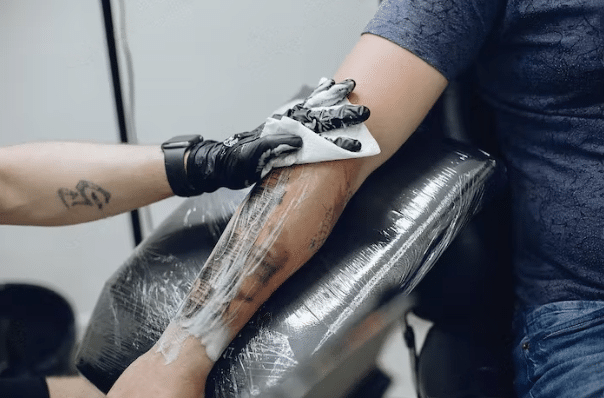
Waterproof tattoos are becoming more popular as people look for ways to protect their skin from the elements. While they may not be suitable for everyone, they offer a unique way to protect your skin from sun and water. Some people choose waterproof tattoos because they want to show their tattoos off while travelling or swimming. Others choose them as a way to protect their skin from extreme weather conditions, such as hurricanes.
Why You Can’t Swim With a New Tattoo
Tattoos have become increasingly popular in recent years, with people of all ages sporting them. However, tattoos can present a major swimming challenge for those who want to participate in any aquatic activity.
The ink from tattoos will cling to the surface of the water and create a mess, and cause infection. It can also obscure your vision and make it difficult to swim effectively. Swimming with a tattoo can also aggravate existing skin conditions, such as dermatitis. In extreme cases, tattoos can block oxygen flow to the body, leading to death. The best way to avoid these dangers is to cover your tattoos while you swim.
How Can I Waterproof A Tattoo For Swimming?
If you’re a fan of swimming and have a tattoo, it’s important to ensure your ink is waterproof. Here are a few different ways to waterproof a tattoo for swimming:
Use a Waterproofing agent: Vaseline
Waterproofing agents have been used in tattoos for years to make them resistant to water and other liquids. The benefits of using a waterproofing agent in a tattoo include preventing fading, staining, and infection. Waterproofing agents also help protect the ink from exposure to environmental elements such as sunlight, wind, and rain. Additionally, using a waterproofing agent can improve the appearance of a tattoo over time by making it less prone to fading.
The most common waterproofing agent is Vaseline, which is effective against both sweat and water. Vaseline is a petroleum jelly that can help your tattoo last longer and maintain its colour. Some key benefits of using Vaseline as a waterproofing agent are that it’s cheap, easy to use, and the desired results will likely be achieved in just a few minutes. Additionally, Vaseline is nontoxic and won’t irritate the skin. Finally, some people find that Vaseline helps keep their tattoos from peeling or blistering.
Wrap The Tattoo In a Waterproof Bandage
A waterproof bandage effectively protects your new ink from water, bacteria, and other contaminants. When you’re done swimming, gently remove the plastic wrap by peeling it off in one piece.
There are many reasons to wrap your tattoo in a waterproof dressing – it’s not just for protection! This kind of bandage makes an excellent barrier against light, which can damage delicate pigments over time. It can also create a waterproof seal, preventing the ink from seeping out and causing infection or smudging. Lastly, a waterproof bandage protects the ink from fading and bacteria.
Be Careful With Your Tattoo Immediately After Your Swim
Immediately after swimming, you must be very careful with any tattoos you may have. While they may be waterproof, the chemicals and sweat from your body could cause them to fade or come off. Avoid direct sunlight and other harsh environments that can damage your tattoo. Keep your new ink clean by using mild soap, cold water, and a cloth to wash it daily as a part of your tattoo aftercare to prevent infection.
The benefits of having a waterproof tattoo after swimming are clear: you won’t have to worry about your new ink smudging or rubbing off, and it will stay in place even if you take a dip. Additionally, the ink will be less likely to fade or rub off if you accidentally get wet and sweaty while wearing it. Plus, since tattoos are often permanent, taking care of them properly is important.
How Long Before You Can Swim With a New Tattoo?

As tattoos become more popular, there is growing concern over when people can safely swim with new tattoos. The tattoo should have no redness, swelling, or pain. Any smaller tattoos may also be safe to swim within two weeks of placement. However, large or vibrant tattoos need at least four weeks to heal before you can swim. If you have questions about whether your new tattoo is safe for swimming, speak to your doctor or a certified tattoo artist.
Conclusion
If you want to stay safe and keep your tattoo waterproof while swimming, it’s important to ensure that the ink is sealed properly.
- Use a good tattoo sealant and follow the instructions on the product packaging. Remember, if you experience any irritation or redness from the sealant, discontinue use and consult a dermatologist.
- You need to seal the ink with a waterproofing agent. Pat the area dry and apply a thin layer of vaseline. Be sure to wait at least 24 hours before swimming, and keep the area clean and dry to avoid irritation or fading.
- Waterproof wraps can help you swim without worrying about your tattoo coming off!
- Check your tattoo from time to time to ensure it is properly waterproofed; if you need to apply more cream, do so.
- Lastly, before deciding to swim, ensure your tattoo is fully healed.
Was this article helpful? Let us know in the comments!
FAQs
Can I swim in a pool with a new tattoo?
Tattoos can be beautiful, but they also come with risks. One of those risks is swimming in a pool containing chlorine and other chemicals. There have been a few cases where people have gotten sick after swimming with new tattoos, but this is very rare. The best way to avoid problems is to discuss any concerns with your artist before getting in the water. If you decide to swim in a pool with a new tattoo, cover it up with a long-sleeved shirt and sunscreen!
Can I cover my tattoo with Saran Wrap?
Saran wrap is a type of plastic wrap that is often used to cover food. It can also cover tattoos to protect them from the elements and other people. Saran wrap is safe for tattoos as long as the wrapping is tight enough not to let air get in or out. If the tattoo needs to be removed, it should be done slowly and carefully so that any pressure put on the skin does not cause damage.
What is the risk of swimming after getting a tattoo?
People who have just gotten a new tattoo should know the risk of getting in the water with it. This is because tattoos are made up of ink and water; when these two mixes, the results can be disastrous. The ink then spreads through the body and can cause serious health problems. In extreme cases, tattoos can spread to other body parts and cause permanent damage. It’s important to keep your new tattoo safe by avoiding any type of water activity until it has been professionally healed.




